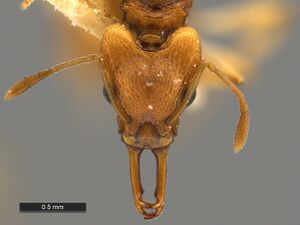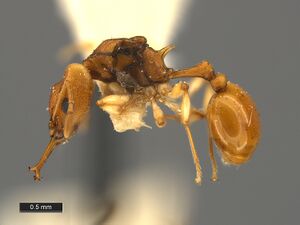Orectognathus sarasini
These interesting ants are found in leaf litter in southern New Caledonia. There are two color morphs, a dark-headed form and a yellow-headed form, or else two sibling species. Workers forage on vegetation at night. Nests are under rocks or in twigs in rainforest leaf litter.
| Orectognathus sarasini | |
|---|---|

| |
| Scientific classification | |
| Kingdom: | Animalia |
| Phylum: | Arthropoda |
| Class: | Insecta |
| Order: | Hymenoptera |
| Family: | Formicidae |
| Subfamily: | Myrmicinae |
| Tribe: | Attini |
| Genus: | Orectognathus |
| Species: | O. sarasini |
| Binomial name | |
| Orectognathus sarasini Emery, 1914 | |
Identification
This species is found in the southern half of New Caledonia. The specimens can be divided between two distinct color forms, which have the same measurements and the same general structure. TL 4.2-5.3, HL 1.07-1.26, HW 0.81-1.00, (CI 76-79), ML 0.64-0.71, (MI 59-60), WL 1.12-1.31 mm. (workers).
A female from series No. 115 measures: TL 5.6, Hl 1.24, HW 1.04 (CI 84), ML 0.69 (MI 56), WL 1.40. A male measures: TL 3.7, HL 0.69, HW 0.74, WL 1.26mm. (Series No. 115).
This species is like Orectognathus antennatus, from which it differs only by minor features; the greater development of the humeral and anterior mesonotal protuberances is a relative character, difficult to appreciate without comparison direct of material of both forms. As Wheeler suggested, it is entirely possible that antennatus and sarasini are conspecific, but in the absence of objective criteria for their true relationship, it seems best to continue to distinguish them as arbitrary species, especially in view of the possible complications next discussed.
Emery described Orectognathus sarasini from Mt. Canala, New Caledonia. Wilson has seen type material, and affirms that it corresponds to a color form that he took, not at Canala, but at Mt. Mou and Le Chapeau Gendarme, which is concolorous clear ferruginous yellow, with only the legs lighter yellow (Mt. Mou: Nos. 115, 141; Le Chapeau Gendarme, No. 91 and Berlese samples). At and around Ciu, on the approaches to Mt. Canala, Wilson collected several series at about 300 m. altitude (Nos. 251, 289, observation colonies CC and EE, berlesates) in which the color of the workers is strikingly different: the color differs from that of sarasini in that the alitrunk and dorsum and sides of the head (except occipital lobes and sides of clypeus) are piceous, appearing black to the naked eye. The remaining parts are ferruginous yellow, although the gula and both notes are slightly tinged with brownish. The female is colored much like the worker.
The male of sarasini is like the antennatus male, but is smaller and with proportionately narrower gaster; the surface of the gaster, while variable, tends to be much more smooth and shining; pubescence of gaster much reduced, less even than in antennatus.
The question arises as to whether the black-and-yellow form truly belongs to sarasini, or is a different species; this question can be answered only by a more intensive study of the distributions of the two types of color pattern. It is interesting to speculate that the original Canala concolorous population may have changed, in a period of four or five decades, to a bicolorous condition. Rapid changes of this type are not unknown in other animal groups.
Of the Mt. Mou collections of the concolorous yellow form, No. 115 was a small colony in a cavity about 3 cm. across under a small rock in wet soil by a stream, altitude between 180 and 400 meters. The colony had a single queen and brood. No. 141 consisted of workers taken foraging on the trunks of two trees growing close together in dry forest; the collection was made during the first two hours of darkness and at a height of from 1-2 m. above the ground. The same spot was visited during daylight hours, but no further specimens were found. At Le Chapeau Gendarme, No. 91 was a nest in a rather dry dead branch, about 7 cm. in diameter, lying on the ground amid dry, thin leaf litter. This colony was observed for a short time in the artificial nest, but during that time it did not feed on any of the collembolans or other small arthropods that were provided. At this locality, stray workers were also taken in leaf litter berlesates.
At Ciu, No. 251 was a colony of about 30 workers, a single dealate female, 3 males, and 20-30 larvae and pupae gathered in a small circular cavity about 4 cm. wide in thin soil collected between two large rocks on the floor of rain forest. No. 289 was a colony taken under a rock in a drier, more open part of the forest. Other samples from Ciu came from soil cover berlesates.
Distribution
Latitudinal Distribution Pattern
Latitudinal Range: -20.73333333° to -22.2°.
| North Temperate |
North Subtropical |
Tropical | South Subtropical |
South Temperate |
- Source: AntMaps
Distribution based on Regional Taxon Lists
Australasian Region: New Caledonia (type locality).
Distribution based on AntMaps
Distribution based on AntWeb specimens
Check data from AntWeb
Countries Occupied
| Number of countries occupied by this species based on AntWiki Regional Taxon Lists. In general, fewer countries occupied indicates a narrower range, while more countries indicates a more widespread species. |

|
Estimated Abundance
| Relative abundance based on number of AntMaps records per species (this species within the purple bar). Fewer records (to the left) indicates a less abundant/encountered species while more records (to the right) indicates more abundant/encountered species. |

|
Additional Specimens
Biology
Small colony size living in twigs in leaf litter or under rocks in leaf litter. Workers forage during the night on low vegetation.
Castes
Workers and male described. Queen known but not described.
Male
   
| |
| . | |
Queen
   
| |
| . | |
Nomenclature
The following information is derived from Barry Bolton's Online Catalogue of the Ants of the World.
- sarasini. Orectognathus sarasini Emery, 1914f: 416 (w.m.) NEW CALEDONIA. Subspecies of antennatus: Wheeler, W.M. 1927i: 125. Revived status as species: Brown, 1953k: 100. See also: Brown, 1958b: 23; Bolton, 2000: 24.
Description
References
- Bolton, B. 1995b. A new general catalogue of the ants of the world. Cambridge, Mass.: Harvard University Press, 504 pp. (page 301, catalogue)
- Brown, W. L., Jr. 1953k. A revision of the dacetine ant genus Orectognathus. Mem. Qld. Mus. 13: 84-104 (page 100, revived status as species)
- Brown, W. L., Jr. 1958b ("1957"). A supplement to the revisions of the dacetine ant genera Orectognathus and Arnoldidris, with keys to the species. Psyche (Cambridge) 64:17-29. (page 23, discussion)
- Emery, C. 1914f. Les fourmis de la Nouvelle-Calédonie et des îles Loyalty. Nova Caled. A Zool. 1: 393-437 (page 416, worker, male described)
- Taylor, R. W. 1980a ("1979"). New Australian ants of the genus Orectognathus, with summary description of the twenty-nine known species (Hymenoptera: Formicidae). Australian Journal of Zoology 27:773-788.
- Wheeler, W. M. 1927i. The ants of Lord Howe Island and Norfolk Island. Proc. Am. Acad. Arts Sci. 62: 121-153 (page 125, Variety of antennatus)
References based on Global Ant Biodiversity Informatics
- Bolton, B. 2000. The Ant Tribe Dacetini. Memoirs of the American Entomological Institute 65
- Brown W. L. Jr. 1953. A revision of the dacetine ant genus Orectognathus. Memoirs of the Queensland Museum 13: 84-104.
- Brown W. L., Jr. 1958. A supplement to the revisions of the dacetine ant genera Orectognathus and Arnoldidris, with keys to the species. Psyche (Camb.) 64: 17-29.
- CSIRO Collection
- Chazeau J., H. Jourdan, L. Bonnet de Larbogne, J. Konghouleux, and T. Potiaroa. 2003. Etude floristique et faunistique de la foret seche de Nekoro, 2 eme partie: evaluation de l'integrite de la faune par l'etude de la myrmecofaune. Lettre de Commande Programme Forêt Sèche /lRD N°l 54/2002/CP
- Emery, C. 1914. Les fourmis de la Nouvelle-Calédonie et des îles Loyalty. Nova Caledonia. A. Zoologie 1:393-437.
- Jennings J. T., L. Krogmann, and C. Burwell. 2013. Review of the hymenopteran fauna of New Caledonia with a checklist of species. Zootaxa 3736(1): 1-53.
- Jourdan H., J. Konghouleux. 2005. Bilan entomologique des noyaux forestiers dits, S2 à S5, à Prony, définies par Goro Nickel SA. Rapport d'Expertise IRD / Goro Nickel SA, 15 pages.
- Taylor R. W. 1979. New Australian ants of the genus Orectognathus, with summary description of the twenty-nine known species (Hymenoptera: Formicidae). Australian Journal of Zoology 27: 773-788.
- Taylor R. W. 1987. A checklist of the ants of Australia, New Caledonia and New Zealand (Hymenoptera: Formicidae). CSIRO (Commonwealth Scientific and Industrial Research Organization) Division of Entomology Report 41: 1-92.
- Wheeler W.M. 1935. Check list of the ants of Oceania. Occasional Papers of the Bernice Pauahi Bishop Museum 11(11):1-56.
- Wheeler, W. M. 1927. The ants of Lord Howe Island and Norfolk Island. Proc. Am. Acad. Arts Sci. 62: 121-153
- Wheeler, William Morton.1935.Checklist of the Ants of Oceania.Occasional Papers 11(11): 3-56














